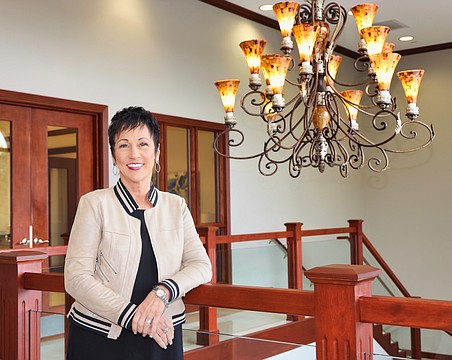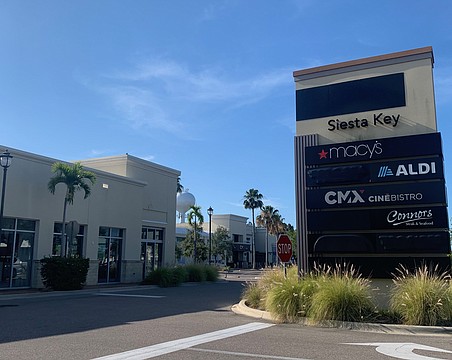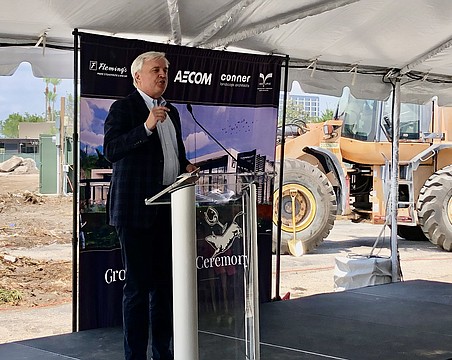'Bring Life to the Streets'
When four-year plans to develop condominiums next to the Quay didn't materialize, Irish developer Paddy Kelly decided to get involved.
By Matt Walsh
Editor
As you look at and listen to Irishman Patrick "Paddy" Kelly, it doesn't take long before you think: Farmer Hoggett. Hoggett, of course, was the gentle English farmer who trained Babe the pig into a champion sheep dog. "That'll do, pig," was Hoggett's famous line.
Kelly looks the part - angular face, tan cheeks and trusting eyes that twinkle when he laughs. He has the Hoggett accent, too - albeit an Irish brogue and a soft voice. And he's tall, more thin than thick.
But Kelly is unlike the stoic, monosyllabic Hoggett - in fact, unlike the stereotypical, fast-paced corporate CEO - in that he comes across as a gentle, friendly man at peace with himself and those around him, a man at ease and open with people and his time.
Kelly, 59 (he'll be 60 in April), heads up the partnership that nearly two weeks ago closed on the $50 million purchase of one of downtown Sarasota's landmarks, the 10.5-acre Quay retail and office complex. He envisions turning it into $1 billion of condominiums, retail stores, restaurants and offices.
Dressed in a tan, casual Louis Copeland linen suit and open-collared shirt, Kelly spoke to GCBR for 90 minutes Feb. 2 in an eighth-floor lounge area of the Ritz-Carlton Sarasota. The interview came after he had already sat for an hour with a reporter from another newspaper.
The conversation with Kelly was wide-ranging - his plans for the Quay, thoughts on Sarasota, how he manages his expanding Dublin-based development and hotel ventures, his philosophies on life and business, Irish history, his family and roots. Through it all, Kelly was remarkably candid and remarkably relaxed for a man whose business ventures encompass office parks, the second-largest Irish hotel chain and a series of office-retail projects that have remade downtown Dublin's skyline over the past decade. Throughout the 90 minutes, he didn't check his watch once.
Here are excerpts of what he said:
The Quay: Why now?
Kelly's purchase was the result of an evolutionary relationship with its previous owner, Canadian/Sarasota businessman Rene Gareau and a group of Gareau's Canadian partners.
Kelly and Gareau have been friends for nearly a quarter of a century. About four years ago, while their two families were vacationing in Sardinia, Gareau showed Kelly a brochure for Villa Siena, a condominium high-rise Gareau wanted to build next to the Quay over the parking lot of the Sarasota Hyatt Resort. Gareau asked Kelly to invest $10,000.
Kelly thought instead he might want to invest more and become a limited partner in the venture. He flew to Sarasota about two weeks later, looked over the property and shook hands with Gareau. Kelly decided to invest $1 million. "We thought it would be nice to have a stake in America," Kelly says. "And maybe we'd end up with a nice apartment."
This was Kelly's first investment in Florida real estate. And he was prepared to be patient. But a year and a half ago, Kelly says, "We moved to take it over (the Villa Siena project). The Canadian partnership was not getting it done. At the same time, we looked at taking over the Quay itself."
On top of that, Kelly says, when he saw the Ritz-Carlton project come to fruition, "we felt Sarasota's time had come."
Kelly's role in the Quay
"America is the new thing for me," Kelly says. And the Quay is - at the moment - the bull's eye of his attention. "You know that old saying, 'We're going to America.' It's very appealing to be involved in America."
Until 18 months ago, the Quay ranked low on Kelly's list of priorities - maybe number 20, he says. "Now it's in the first five. For January and February, it's number one. I have to pay attention now."
Kelly says his job with the Quay is "to get the concept right, put it on paper and get the support of the community." Toward the latter, he already has met several Sarasota city and county elected officials, including Sarasota Mayor Lou Ann Palmer, City Commissioner Mary Anne Servian, Sarasota County Commission Chairman Jon Thaxton and Congresswoman Katherine Harris. Last weekend, he attended the tribute dinner of the Sarasota Film Festival. "There's a real welcome here," he says. "I didn't think the Quay was that important."
Kelly's role with the Quay also will include assembling the team to bring it to fruition. Kelly expects to engage Sarasota architects, engineers and other professionals, as well as his existing network of professionals in Ireland. Jeff Gareau, Rene's son, will be the on-site manager of the Quay's redevelopment. Kelly also mentioned Sarasota planner Bruce Franklin of the ADP Group and Sarasota architect Rick Gillett, who designed Villa Siena. And he says he'd like to develop partnerships with Bob Buford, one of the developers of the Ritz-Carlton; WCI Communities Inc., developer of the Tower Residences at the Ritz; and the owners of the Sarasota Hyatt. He wants to link the Quay with each of their ventures.
Kelly's banker will remain his longtime finance partner, Dublin-based Anglo Irish Bank Corp. "It took a while to persuade them to come to America," Kelly says. Anglo Irish provided a $12 million mortgage on the Quay's purchase.
What he evisions at the Quay
Kelly doesn't have his concept drawings on paper yet. He says he might consider conducting a small international design competition. But his timetable includes the end of June as the date he wants to have drawings to present.
Meantime, Kelly will continue his efforts to create the overall palate for the new Quay. He and Gareau have traveled extensively for more than a year to such places as London, Paris and Rome for ideas. While in Florida this month, he'll visit Winter Park, near Orlando. And in the next few weeks he'll be spend a week in Japan exploring retail projects.
Specifically, Kelly so far envisions building:
× About 100,000 to 120,000 square feet of retail space (currently the Quay consists of just under 125,000 square feet in retail, 75,000 in office);
× 100,000 to 150,000 square feet of office space;
× About 600,000 square feet of apartments and condominiums with related hotel services;
× And 400,000 to 500,000 square feet of what he calls pure condos.
"If the conference center happens," he says, "we'd probably have about 400 to 600 hotel rooms."
The condos would range in size from 1,000 to 1,500 square feet and sell for an average of $500,000 to $750,000. "That'll be market driven, of course."
Structurally, Kelly envisions shops and restaurants on the street level, with sheltered walkways to protect pedestrians from the weather and lush landscaping. "We want it to be a place where people park their cars and walk," Kelly says. "Bring life to the streets."
Offices and condominiums would go above the retail and "be plugged into the hotels."
Asked about previously published reports in Ireland that Kelly was considering as many as seven 22- and 38-story towers, he says: "It's not our plan. You can't come here and build an ugly thing."
Will he build a conference center?
"We'd love to have a conference center - if it makes sense," Kelly says. "My sense is there should be a conference center. But we have no intention of building one unless the city wishes us to do it."
In that event, Kelly says, he would envision perhaps a 50%-50% investment arrangement. But he is skeptical. "They're generally not viable as a business." Subsidies are typically are needed.
If a conference center were to be built, Kelly says it likely would be built on an outparcel on the northeast quadrant of the Quay's property and possibly include land occupied by adjacent low-rise apartments.
Impression of Sarasota
When Kelly visited Sarasota four years ago to decide whether to invest in the Villa Siena condominium project, his first impression of Sarasota was this: "What surprised me was the lack of good shopping facilities downtown."
Nonetheless, the city's cultural offerings impress him. Says Kelly: "My dream would be to have a condo here linked to the hotel services. I'd love to come here on a regular basis."
KELLY'S VENTURES
Office parks and buildings - Under a variety of operating partnerships, Kelly is one of Ireland's most active developers of large (more 200,000 square feet) mixed-use commercial projects.
Redquartz Ltd. - Based in Dublin, this is the management company for all of Kelly's businesses. It handles such things as the businesses' accounting and human resources.
Prem Group - This includes four businesses: Days Serviced Apartments, which provide fully furnished apartments for the corporate and leisure sector in Dublin, Manchester, Liverpool, Bristol, Nottingham. Premier Business Centres provide companies with furnished offices, complete with computers and telephones, secretarial staff and catering; 16 locations in Dublin and Belfast; Premier Hotels owns and manages Wingate, Days Inn, Quality, Clarion and Choice brands; Premier Meeting Rooms provides off-site meeting space at the Premier Business Centres.
An Irishman's Circles of Life
Paddy Kelly left formal schooling at age 16 when his father was diagnosed with multiple sclerosis. The lack of classroom education didn't prohibit or inhibit his intellectual development.
Kelly is an avid reader of business and spiritual books. The Dali Lama and Warren Buffett are two of his favorite reading topics. He talks with great fluency and detail about Irish history and the evolution of its economy. Jeff Gareau, the on-site manager of the Quay project, marvels at Kelly's financial mind. "He has an incredible retention and memory of numbers," says Gareau. And by way of 43 years of observation and experience as an entrepreneur, Kelly has formed some well-grounded philosophies on life, family and business management.
During his interview with GCBR last week, the Irish developer sketched out those philosophies on a sheet of note paper. To the naked eye, they might look the like the doodles of a nutty scientist, but there's insightful thinking behind all of those circles:
Three stages of life
In the accompanying drawing, the top set of three circles, each with three other circles inside them, illustrates the decades of our lives. The first three circles cover the decades from birth through age 29; the next three are a person's 30s, 40s and 50s; and then 60s, 70s and 80s.
"The first 30 years are really formative," Kelly says. "People in their 20s definitely need help and guidance. The next 30 are the implementation years. And the final years are the donor years."
Organizational business structure
Kelly eschews the typical autocratic corporate pyramid with a chief executive officer and grand poobah at the top. "Weary is the head who carries the crown," Kelly says.
Instead of the traditional organization structure, Kelly shapes his companies around partnerships and descendants and associates of those partners. In all of his ventures, he has partners. One Irish newspaper listed names of Kelly's partners in Ireland and called them the "who's who in the Irish property market" - Phil Monahan, John Flynn, John Walshe, John McCormack, Jarlath Sweeney and Joe Linders.
For Kelly, long-term relationships are the key. "The reward in life is really those long-term relationships," he says.
So if you look at the middle doodle in the illustration, the circles in the top row represent Kelly's business partners. Beneath each of those partners are circles representing his partners' children and close family members. Kelly himself has four children, ages 34, 32, 26 and 18.
The patriarchs bring their descendants into their businesses, and "what happens," Kelly says, "is cross fertilization. You get a support system for one another and people who are good at different things."
The "x" in the illustration represents the cross-fertilization, the tapping of each other's skills.
Kelly's management style in this structure is "consultative" and "creating goals that have enlightened self-interest." In other words, key people in all of Kelly's businesses have equity ownership that gives them financial incentives to perform. "We're all partners in the business," he says.
'I' people, 'we' people
Kelly has two categories for people - "I people," or "we people."
This is the third scribbling on the accompanying drawing. Each type of person casts different energy. "I people" - typically those who shun working with others or managers who try to do everything themselves - will see their energy dissipate. They will wither.
"We people," on the other hand, gain momentum and energy by bringing others into their circle. Thus Kelly's rising line of circles.
The four legs of life
The four circles at the bottom of Kelly's doodling represent four aspects of everyone's life:
× The first is self-development. "We have a duty to self-development," Kelly says.
× The second leg: Family "Care for the family unit is essential," he says.
× The third: Business. "Your business has to grow as well."
× Fourth: Community involvement. "You have to be mindful of the needs of the community," Kelly says. "We're all part of the whole."





